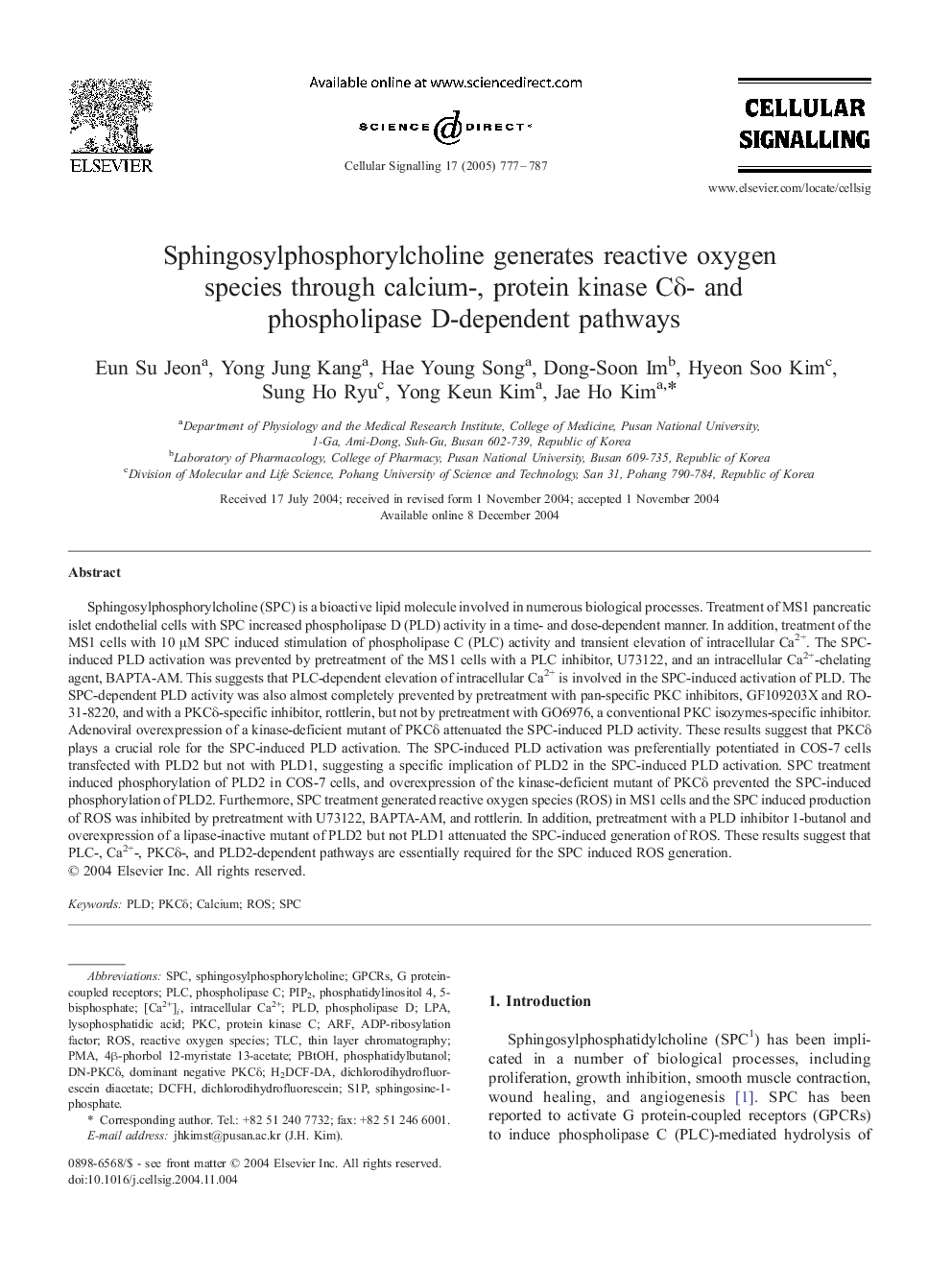| کد مقاله | کد نشریه | سال انتشار | مقاله انگلیسی | نسخه تمام متن |
|---|---|---|---|---|
| 10816402 | 1058569 | 2005 | 11 صفحه PDF | دانلود رایگان |
عنوان انگلیسی مقاله ISI
Sphingosylphosphorylcholine generates reactive oxygen species through calcium-, protein kinase Cδ- and phospholipase D-dependent pathways
دانلود مقاله + سفارش ترجمه
دانلود مقاله ISI انگلیسی
رایگان برای ایرانیان
کلمات کلیدی
PLDPIP2H2DCF-DAPKCδARFLPAS1PPKCPLCdichlorodihydrofluoresceinGPCRsDCFHSPCTLC4β-phorbol 12-myristate 13-acetate - 4β-فروبل 12-مریستات 13-استاتG protein-coupled receptors - G گیرنده های پروتئینی همراهPMA - LDC هاROS - ROS[Ca2+]i - [Ca2 +] iSphingosylphosphorylcholine - اسپینگزیل فسفرییل کلینSphingosine-1-phosphate - اسپینگسین-1-فسفاتlysophosphatidic acid - اسید لیسفسفیدیدIntracellular Ca2+ - داخل سلولی Ca2 +dichlorodihydrofluorescein diacetate - دی کلستیدوفروفوروزین دی سکتهADP-ribosylation factor - فاکتور ADP-ribosylationphosphatidylbutanol - فسفاتیدیل بوتانولphosphatidylinositol 4, 5-bisphosphate - فسفاتیدیلینواستول 4، 5-بیسفسفاتphospholipase C - فسفولیپاز CPhospholipase D - فسفولیپاز DProtein kinase C - پروتئین کیناز سیthin layer chromatography - کروماتوگرافی لایه نازکCalcium - کلسیمReactive oxygen species - گونههای فعال اکسیژن
موضوعات مرتبط
علوم زیستی و بیوفناوری
بیوشیمی، ژنتیک و زیست شناسی مولکولی
زیست شیمی
پیش نمایش صفحه اول مقاله

چکیده انگلیسی
Sphingosylphosphorylcholine (SPC) is a bioactive lipid molecule involved in numerous biological processes. Treatment of MS1 pancreatic islet endothelial cells with SPC increased phospholipase D (PLD) activity in a time- and dose-dependent manner. In addition, treatment of the MS1 cells with 10 μM SPC induced stimulation of phospholipase C (PLC) activity and transient elevation of intracellular Ca2+. The SPC-induced PLD activation was prevented by pretreatment of the MS1 cells with a PLC inhibitor, U73122, and an intracellular Ca2+-chelating agent, BAPTA-AM. This suggests that PLC-dependent elevation of intracellular Ca2+ is involved in the SPC-induced activation of PLD. The SPC-dependent PLD activity was also almost completely prevented by pretreatment with pan-specific PKC inhibitors, GF109203X and RO-31-8220, and with a PKCδ-specific inhibitor, rottlerin, but not by pretreatment with GO6976, a conventional PKC isozymes-specific inhibitor. Adenoviral overexpression of a kinase-deficient mutant of PKCδ attenuated the SPC-induced PLD activity. These results suggest that PKCδ plays a crucial role for the SPC-induced PLD activation. The SPC-induced PLD activation was preferentially potentiated in COS-7 cells transfected with PLD2 but not with PLD1, suggesting a specific implication of PLD2 in the SPC-induced PLD activation. SPC treatment induced phosphorylation of PLD2 in COS-7 cells, and overexpression of the kinase-deficient mutant of PKCδ prevented the SPC-induced phosphorylation of PLD2. Furthermore, SPC treatment generated reactive oxygen species (ROS) in MS1 cells and the SPC induced production of ROS was inhibited by pretreatment with U73122, BAPTA-AM, and rottlerin. In addition, pretreatment with a PLD inhibitor 1-butanol and overexpression of a lipase-inactive mutant of PLD2 but not PLD1 attenuated the SPC-induced generation of ROS. These results suggest that PLC-, Ca2+-, PKCδ-, and PLD2-dependent pathways are essentially required for the SPC induced ROS generation.
ناشر
Database: Elsevier - ScienceDirect (ساینس دایرکت)
Journal: Cellular Signalling - Volume 17, Issue 6, June 2005, Pages 777-787
Journal: Cellular Signalling - Volume 17, Issue 6, June 2005, Pages 777-787
نویسندگان
Eun Su Jeon, Yong Jung Kang, Hae Young Song, Dong-Soon Im, Hyeon Soo Kim, Sung Ho Ryu, Yong Keun Kim, Jae Ho Kim,